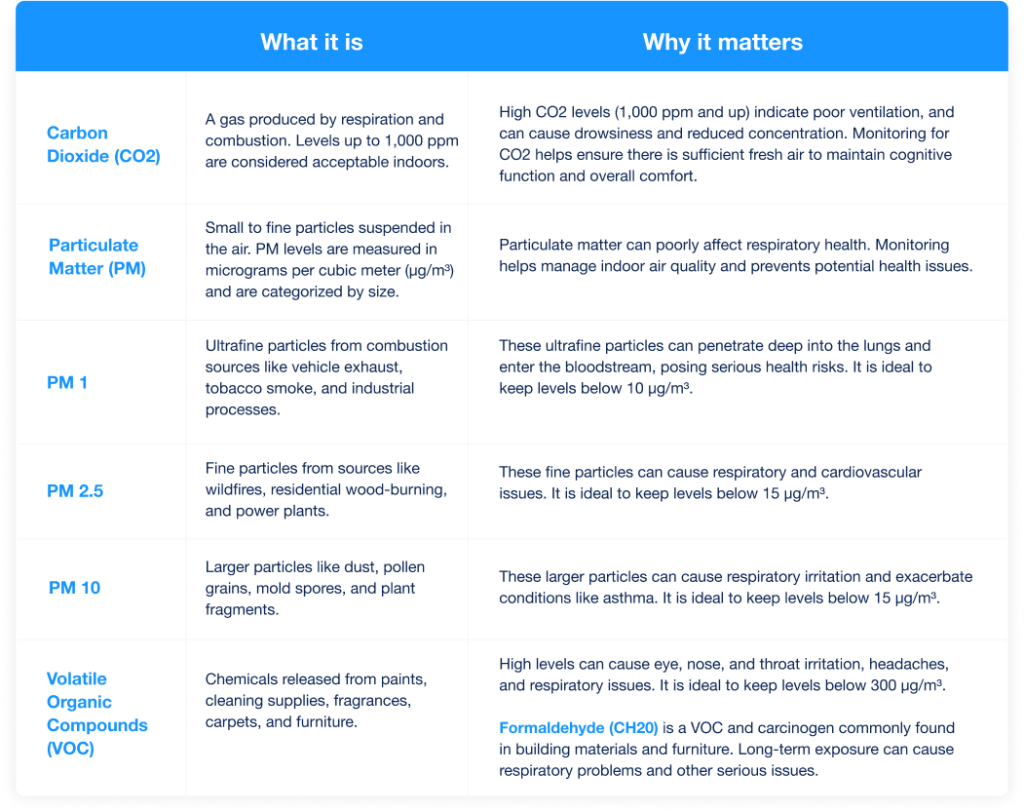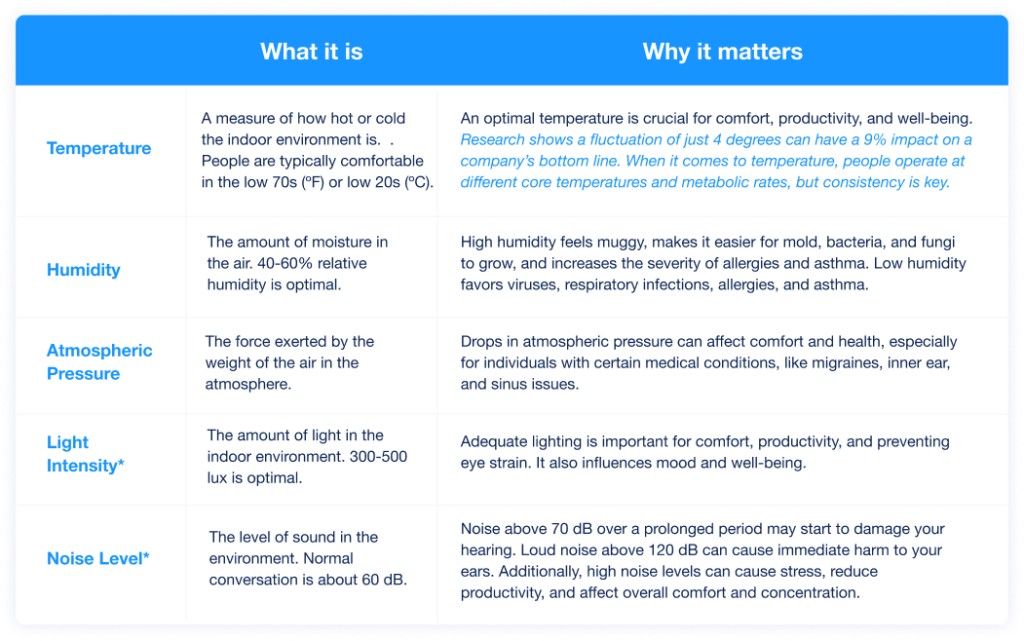
Why should I improve indoor air quality (IAQ) & indoor environmental quality (IEQ) in my buildings?
The Importance of Healthy Indoor Air Quality
Clean air and proper ventilation indoors is crucial for the creation of high-performance work places, classrooms, and healthcare environments. It’s also essential in fostering comfort, productivity, and well-being for your building occupants.
Imagine walking into a building optimized for health and comfort. The air feels fresh and light. There are no musky or overly fragrant smells. The temperature is pleasantly cool and refreshing, and the lighting is neutral and natural. What could you accomplish in a space like this?
In this section, we will build on our understanding of IAQ and IEQ and answer some key questions tied to its importance as part of a smart building strategy.
What to monitor in your indoor environment
Managing IAQ and IEQ is crucial to enabling optimal occupant comfort and well-being. Below are the essentials to measure, and more importantly, to manage against.
Indoor Air Quality Measures

Indoor Environmental Quality Measures

Why should I improve IAQ & IEQ in my buildings?
There are many reasons building owners, operators, and their tenants should be focusing on IAQ and IEQ.
IAQ’s influence on well-being and productivity
Exposure to high concentrations of indoor air pollutants can lead to “sick building syndrome,”which is associated with headaches, fatigue, respiratory issues, and impaired cognitive function. The culprit can often be poor ventilation and high CO2 levels.
In newly built and furnished spaces, it may be over-exposure to formaldehyde or in locations that require frequent surface cleaning, the effects of chemical cleaning agents.
Whatever the cause, real-time air quality monitoring is an ideal method to protect occupants by enabling corrective action. Monitoring for these common pollutants like CO2, particulate matter, and volatile organic compounds off-gassed from new furniture or cleaning sprays, empowers building owners and operators to proactively identify, mitigate, and prevent indoor air quality issues affecting occupants.
IAQ for the pursuit of Green Buildings
Green and healthy building certification programs like LEED, RESET, WELL and fitwel are becoming standard practice across commercial buildings driven by tenant demand, statewide and federal climate regulations, corporate sustainability goals, and the need to maintain a competitive edge in market. Air quality monitoring and performance benchmarks can be used as an important means to score against and meet applicable certification requirements.
Ensuring compliance with building standards is another important component of meeting green and healthy building standards. Just last year, ASHRAE, the American Society of Heating, Refrigerating, and Air-Conditioning Engineers, released updated ventilation standards intended to drive improvements in indoor air quality and reduce the spread of airborne illness.
These new standards require a significant increase in equivalent air changes (eACH) per hour as changes in occupancy occur (and CO2 levels increase), where integrating real-time air quality and occupancy data into smart HVAC controls provides the means to track, control, and report on the required eACH.
For more insights on how monitoring IAQ and IEQ can feed into a smart building strategy, check out R-Zero’s Q3 Building Intelligence Index: The Business Case for Comfort.
More posts you might like
-

How to Improve Indoor Air Quality in Your Buildings
As a building owner or operator, ensuring optimal indoor air quality (IAQ) in your spaces is essential for the well-being and productivity of your tenants and occupants. To help you get started, here’s a guide to ensure you are meeting indoor air quality standards across your real estate portfolio. Understanding Indoor Air Quality Standards To […]
-

The importance of indoor air quality testing in office buildings
In today’s workplace, ensuring a healthy and productive environment for employees is crucial. One of the most significant factors influencing workplace well-being is indoor air quality (IAQ). As part of our focus on smart buildings, R-Zero offers advanced indoor air quality testing solutions like the R-Zero IAQ Monitor, designed specifically for enhancing occupant comfort and […]
-

The Value of Improving Indoor Air Quality in Buildings
Understanding and improving indoor air quality is important because it ensures your indoor spaces are providing adequate ventilation and keeping building tenants comfortable, productive, and healthy. Indoor air quality monitoring is also a strategic tool that can help you reduce unnecessary energy costs tied to overrunning your HVAC systems to increase ventilation in your spaces. […]

